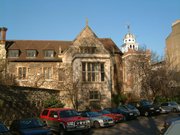London Charterhouse
|
|
Charterhouse_Hospital,_engraved_by_Toms,_c.1770..jpg
| Contents |
Introduction
The name Charterhouse is an English corruption of the French maison chartreuse, a religious house of the Carthusian order. As such it occurs in England in such names as Charterhouse-on-Mendip and Charterhouse Hinton where the Carthusians were established. It is most familiar, however, in its application to the London Charterhouse.
Early History
The London Charterhouse was set up as a Carthusian monastery in 1371 by Walter de Manny, in Smithfield to the north west of the City of London. It was set up near a 1348 plague pit where many victims of the Black Death were buried. The twenty-five monks each had their own small building and garden. Thomas More came to the monastery for spiritual recuperation.
Dissolution
The monastery was closed in 1535, in the Dissolution of the Monasteries in the English Reformation. As it resisted dissolution the monastery was treated harshly: the Prior, John Houghton was hanged, drawn and quartered at Tyburn and ten monks were taken to the nearby Newgate Prison; nine of these men starved to death and the tenth was executed three years later at Tower Hill.
Post Dissolution History
The site was subsequently used by Lord North and the Duke of Norfolk as a home. In 1558, while in the possession of Lord North, it was occupied by Queen Elizabeth I during the preparations for her coronation. Ricardo Ridolfi was arrested in the House and the Ridolfi plot of 1571 failed and was followed by the execution of Norfolk June 2nd 1572. During this period the Bassano family of musicians, originally from Venice, also had some involvement with the house.
James I held court here on his first entrance into London in 1603. The Charterhouse was then in the hands of Thomas Howard, earl of Suffolk (son of the executed Duke of Norfolk), but in May 1611 it came into those of Thomas Sutton (1532-1611) of Snaith, Lincolnshire. He acquired a fortune by the discovery of coal on two estates which he had leased near Newcastle-on-Tyne, and afterwards, removing to London, he carried on a commercial career. In the year of his death, which took place on the 12th December 1611, he endowed a hospital on the site of the Charterhouse, calling it the hospital of King James; and in his will he bequeathed moneys to maintain a chapel, hospital (almshouse) and school. The will was hotly contested but upheld in court, and the foundation was finally constituted to afford a home for eighty male pensioners (gentlemen by descent and in poverty, soldiers that have borne arms by sea or land, merchants decayed by piracy or shipwreck, or servants in household to the King or Queens Majesty), and to educate forty boys. The school, Charterhouse School, developed beyond the original intentions of its founder, and now ranks among the most eminent public schools in England. In 1872 it was removed, during the headmastership (1863-1897) of the Rev. William Haig-Brown (d. 1907), to new buildings near Godalming in Surrey, which were opened on the 18th June in that year.Modern History
The buildings were badly damaged in the Blitz but are now restored and some medieval and 16th Century fabric remains. Charterhouse School moved out in 1872, being replaced (till 1933) by the Merchant Taylors' School, but Charterhouse is still home to senior (male) citizens. The pensioners still occupy their home, picturesque figures in the black gowns designed for them under the foundation. The school buildings on the site of the former monastic cloister eventually became the home of the St Bartholomew's Hospital Medical School, and remain (though now much redeveloped) one of the sites of its successor, Barts and The London, Queen Mary's School of Medicine and Dentistry. The site is also home to Queen Mary Intellectual Property Research Institute and the school of radiography of The City University. The main part of the cloister garth continues to be a pleasant lawn in the quadrangle of the university site.
Visitor information
The Charterhouse itself may be visited by guided tour only, usually at a fixed time one day a week in the summer months. The tour, usually delivered by one of the elderly gentlemen residents, has been found interesting and pleasing by many visitors. The southern side of the outside is open to view from Charterhouse Square, which is publicly accessible. The university site is not open to visitors but may be glimpsed from the gates in the NE corner of Charterhouse Square or seen from the Charterhouse tour if it reaches the terrace on top of the former tennis court walkway along the side of the old cloister: this overlooks the entire quadrangle.
The nearest tube is Barbican but Farringdon tube and surface rail station is also close.

